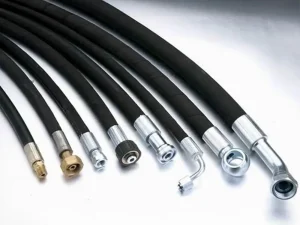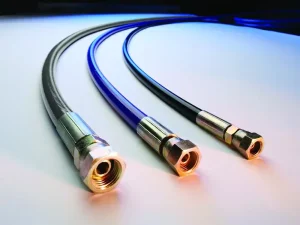Hydraulic hoses are powerful tools that are an essential part of modern machinery. You can find them in cranes, trucks, and factory machines quietly carrying high-pressure fluids. This fluid helps the machines move, lift, and perform heavy-duty tasks. However, not all the hoses are the same; there are several types of hydraulic hoses, each made for a special task.
These types differ in task, design, and pressure handling. Thus, understanding their types is crucial to selecting the right hose. Remember, a wrong hose can cause leakage, safety risks, or machinery failure. Are you new to hydraulic hoses and their types? Worry not! This article will explore different types in the simplest possible way. So, let’s get started!
Overview of Hydraulic Hoses

A hydraulic hose is a flexible tube that carries high-pressure fluid within a machine. It is an essential part of the hydraulic system that powers different machine components. Hoses connect different parts like valves, pumps, and cylinders. As a result, fluid flows easily and creates movement in other parts of the machinery.
Hydraulic hoses play a crucial role in several industries. The first reason for their wide use is their intense flexibility. This means they can be bent and twisted to handle different environments and spaces. Moreover, their robust structure helps in handling and transporting high-pressure fluid. Therefore, hydraulic hoses are used in several industries, including:
- Construction industries for cranes and loaders.
- The automotive industry uses them for brakes and power steering.
- They are used in modern factories for press machines and robots.
- The marine industry uses them on offshore drilling platforms and ships.
Composition
Hydraulic hoses are made to be strong, durable, and flexible. Different types of hoses vary in composition due to the handling of various fluids. However, their main compositions include three main layers.
- Inner Tube: This is the inner part that directly touches fluid. Therefore, it must be compatible with fluid so it does not break down. It is mainly made of rubber or plastic.
- Reinforcement Layer: It is the middle layer that gives strength to the hose. It helps the hose to stay stable and prevent bursting. This layer is made with steel or spiral wires.
- Outer Cover: This is the outermost layer that protects the hose. It remains in continuous contact with the external environment. Therefore, it must be heat resistant and prevent abrasion and damage.
Working
Hydraulic hoses carry fluid from one part of the machine to another. This fluid is usually oil that powers machinery parts to do their job. The working of these hoses is very straightforward. For example, the hydraulic system starts, and the pump pushes the fluid into the hose. The high-pressure fluid travels through the hose.
The hose carries this fluid to hydraulic parts such as motors. The motor uses the pressure of a liquid to create mechanical movement. This movement helps different parts do their jobs, such as lifting or pushing heavy things. After the job is done, the hydraulic fluid returns to the reservoir or tank. The cycle starts when you start the machinery.
Types of Hydraulic Hoses
I hope the above section has cleared all of your queries. Now, let’s explore different types of hydraulic hoses and see how they differ.
1- Spiral Reinforced Hydraulic Hoses

It is a special type of hydraulic hose designed to handle high pressure. These hoses have a multilayer of steel wires wrapped in a spiral pattern around the hose. This steel cage gives the hose extra strength, allowing it to carry harsh fluids without risk of bursting or breaking.
Because these hoses are designed for demanding operation, they have a higher hydraulic hose pressure rating. This rating tells us how much pressure a hose can handle safely. The higher the rating, the stronger the hose. Hence, these hoses are typically used in construction machines and mining vehicles.
2- Braided Hydraulic Hoses
It is the most commonly used type of hydraulic hose. These hoses typically handle medium to high-pressure fluid. Their design includes two or more wires wrapped around the inner tube. These wires are wrapped in a way that looks like a braid or woven net. Therefore, they are named braided hydraulic hoses.
Unlike spiral hoses, braided hoses are not stiff. Their braided design provides them with a higher level of flexibility and strength. Therefore, these hoses are the best choice for machines that need to move a lot in a congested space. Moreover, depending on the number of wire layers, these hoses can vary from one another.
3- Thermoplastic Hydraulic Hoses

This type of hydraulic hose is mainly made of thermoplastic instead of rubber. This material provides them with flexibility and chemical resistance. That’s why they can handle different harsh external environments. For example, you can use these hoses in extreme cold and heat.
One significant advantage of thermoplastic hoses is that they are lightweight and compact. It means they are easy to install and move in narrow spaces. Instead of being lightweight, they can still handle high-pressure fluids. Moreover, these hoses are non-conductive. This makes them perfect for working around electrical machinery.
4- Teflon (PTFE) Hydraulic Hoses
Teflon hydraulic hoses are made with special plastic Polytetrafluoroethylene(PTFE). This material is robust and efficiently resists heat and chemicals. Therefore, these hoses can easily handle aggressive and high-temperature fluids without bursting. What makes them more special is their non-stick nature. It means they allow fluid flow without leaving residue behind.
Therefore, Teflon hoses are also easy to clean and ideal for applications that require higher cleanliness. Moreover, these hoses are stiffer, requiring a precise and careful connection. That’s where hydraulic fitting installation becomes essential. A poor installation of these hoses leads to leakage and safety hazards.
5- Suction and Return Hoses
These low-pressure hoses move hydraulic fluid in and out of the system. The suction hose is present at the pump’s inlet. Its job is to pull the fluid from the reservoir and send it to the machine parts. These hoses are mainly thicker and reinforced to prevent collapsing during pulling.
However, return hoses are present at the end of the hydraulic system. After the machine has done its job, the hydraulic fluid moves through this hose and returns to the reservoir. Simply put, both hoses are like blood vessels that ensure fluid flow in a hydraulic system. These hoses are mainly made with flexible rubber or synthetic material.
6- Specialty Hoses
Specialty hoses, or custom-made hoses, are designed for particular tasks. Manufacturers create these hoses according to industry requirements. For example, if an industry needs a hose that can resist fire or heat, it will use a custom-made hose. This hose might have special shields, such as extra layers or sleeves, that protect it from fire.
Specialty hoses vary in material, length, diameter, and flexibility. Their creation and installation involve a proper hydraulic hose assembly process. It means they must be made with the right material and have the correct fitting to avoid leakage. Therefore, these hoses are used in aerospace and military industries where safety is critical.
7- Fleet Hydraulic Hoses
Fleet hoses are specially designed for vehicles that use hydraulic systems. These hoses are mainly used in buses, trucks, and construction vehicles. They transfer hydraulic fluid to power the parts, such as brackets, steering, and lifts. As a result, those parts work and run smoothly.
What makes fleet hoses unique is their ability to resist vibrations. As you know, vehicles remain in constant motion and face heat, cold, and debris. But these hoses contain braids or wires that help them handle all those harsh conditions. Moreover, fleet hoses come in standard sizes and fittings. Thus, they are very easy to replace, fix, and repair.
8- Coiled Hydraulic Hoses
Coiled hoses look like spirals or springs. Instead of flat hoses, they are twisted into a coil. When you pull a coiled hose, it stretches; however, when you let it go, it returns to its original shape. These hoses are great as they move when you need them, but stay out of the way when not required.
This design makes them space-saving and keeps the area clean and safe. Moreover, they also last long as they do not drag against roads or harsh surfaces. However, they cannot handle high-pressure fluids. Therefore, coiled hoses are used in garage tools, car lifts, and small moving machines.
Factors to Consider When Choosing Hydraulic Hoses
Choosing the right hose is very important for the safety and life of the machine. The wrong hose for a long project can lead to leakage and financial loss. So, before buying and installing a hydraulic hose, you must consider some factors. Let’s explore those factors in this section.
- Pressure Rating: The pressure rating tells us how much pressure a hose can handle. Every type of hose varies in this rating. Some are made for low pressure, while some can handle high pressure. So always check the pressure rating and choose the correct option.
- Type of Fluid: Hydraulic fluid carries special liquids, such as oil and water. But not every hose is suitable for every fluid. Some can react badly with fluid, damaging the hose. So be careful and choose the hose that is more compatible with your system.
- Temperature: Each type of hydraulic hose has a different temperature range. Some can handle high heat, while some are designed for cold. So, first, evaluate the weather conditions in which you want to use the hose. Then, choose the hose with a suitable temperature range.
- Safety Standards: Always choose a hose that meets industry safety standards. These standards ensure that the hose is safe to use and of high quality. Using a low-quality hose may save you money for now, but its damage will cost you later.
- Maintenance: Not all types of hoses offer equal maintenance. Some are easier to check, clean, install, and replace, while some are not. For regular usability, you should choose the hose that provides easy maintenance. It will save you cost and time.
Frequently Asked Questions
How often should I replace a hydraulic hose?
Typically, a hydraulic hose can last for 5-10 years. However, frequently check for leaks, bulges, stiffness, and cracks. If you notice these signs, replace them immediately.
Can hydraulic hoses be reused?
Hydraulic hoses often cannot be reused. Once they are used, they may have wear and internal damage that is not visible. Reusing those hoses can lead to leaks, bursts, and machinery failure.
Why do hydraulic hoses burst?
Hydraulic hoses often burst due to high pressure or old age. When pressure is high inside the hose, it cannot handle it, so it cannot hold and burst. That’s why choosing the proper hose is crucial.
Conclusion
Hydraulic hoses seem simple, but they help several industries run their operations. These hoses come in various types, each with its own strengths and weaknesses. Therefore, knowing these types’ differences is crucial to selecting the right hose for the right job.
For example, some hydraulic hoses are designed for low-pressure fluid. However, some can handle aggressive and high-pressure fluids. Moreover, these types also vary in temperature handling and maintenance. Now that you have understood the main types and their use from this article, it’s easy to make a confident decision.
